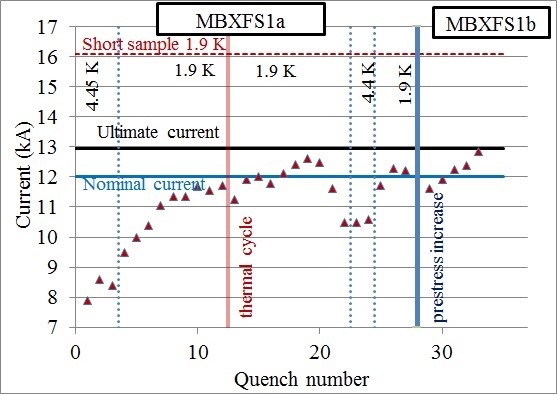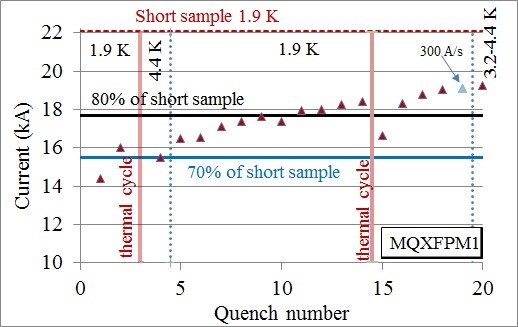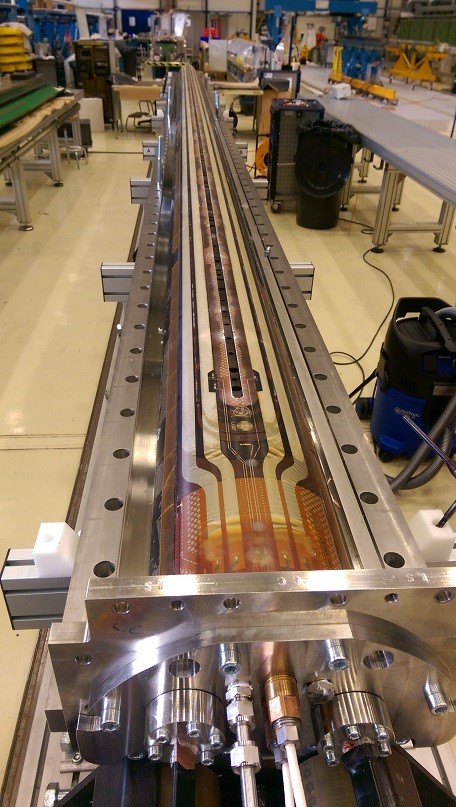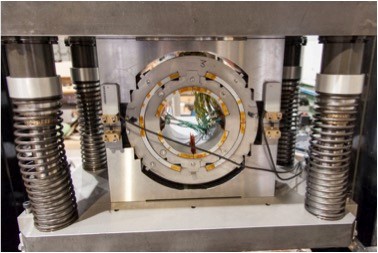![]() Progress in the interaction region magnets of HL-LHC
Progress in the interaction region magnets of HL-LHC
by Ezio Todesco (CERN)
During the past months, significant advancements have been done in the development of the interaction region magnets for HL-LHC.
In KEK, Japan, the short model of the separation dipole D1, that showed insufficient quench performance after the first test, has been disassembled. Significant movements of the coils (up to few mm) were observed in the heads, and a clear evidence of a lack of prestress in the straight part was found. The new assembly took place during winter, and a prestress increase in the straight part of about 35 MPa has been achieved. The magnet was tested in February, reaching nominal current after 2 quenches and ultimate after 5 quenches (see Figure 1). “The magnet performance is now in line with the project requirements – says T. Nakamoto, in charge of the D1 project – we will have a warm-up and cool-down to prove the magnet memory in the next weeks”. The short model design is being updated in some features of the iron yoke, and to account for an unexpected contribution to field quality from the coil heads in the strong regime of saturation. A second model will be built in the second part of 2017, and tested in 2018.

Figure 1: Training of MBXFS1 in KEK: quenches (markers), nominal and ultimate current (solid lines) and short sample limit (dotted line). (Credit: HL-LHC WP3 collaboration)
In the US, the first 4-m-long coil has been tested in a mirror configuration, reaching 85% of short sample limit (see Figure 2). “This is the new world record for coil length in Nb3Sn accelerator magnets – says G. Ambrosio, in charge of the US contribution for the triplet - and paves the way to the assembly and test of the first 4-m-long quadrupole, to be done in the second part of the year”. At the same time at CERN the first 7.15-m-long dummy coils are being produced to validate the assembly procedures (see Figure 3).

Figure 2: Training of mirror 4-m-long coil in BNL: quenches (markers), 70% and 80% of short sample (solid lines) and short sample limit (dotted line). (Credit: HL-LHC WP3 collaboration)

Figure 3: Winding of the first 7.15-m-long dummy coil of the triplet quadrupole at building 180 (CERN)
Furthermore, in CIEMAT, Madrid, the prototype for the nested orbit correctors is entering the construction phase. The concept of double collaring has been validated on a mechanical model with the final design of the collars and a dummy coil made of aluminum (see Figure 4). This is an important step of the validation of the mechanical concept of this magnet, where a mechanical lock between the horizontal and vertical dipoles is required to control the large torque. In particular, the second collaring of the outer dipole on the inner one is critical. “Both collaring operations were in line with our expectations, and we managed to insert pins without any criticality – said F. Toral from CIEMAT, in charge of the Spanish contribution for the orbit correctors – we saw some asymmetries that need more investigations, but given the complexity of the design, this is a very encouraging first step towards construction”.

Figure 4: Double collaring of the nested corrector in CIEMAT
Finally, in LASA, Milano the activity on the high order corrector prototypes is at full speed. After the successful test of the sextupole, the first decapole coil in a single coil configuration has been tested successfully. The coil reached twice the ultimate current with negligible training, thus proving the assembly procedures and tooling concepts. LASA is working in parallel on two magnets: besides the first decapole coil, eigth octupole coils have been completed and will be assembled in the first prototype, and tested in April.
